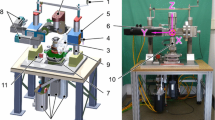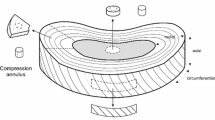Abstract
Purpose
Part I of this study explored mechanisms of disc failure in a complex posture incorporating physiological amounts of flexion and shear at a loading rate considerably lower than likely to occur in a typical in vivo manual handling situation. Given the strain-rate-dependent mechanical properties of the heavily hydrated disc, loading rate will likely influence the mechanisms of disc failure. Part II investigates the mechanisms of failure in healthy discs subjected to surprise-rate compression while held in the same complex posture.
Methods
37 motion segments from 13 healthy mature ovine lumbar spines were compressed in a complex posture intended to simulate the situation arising when bending and twisting while lifting a heavy object at a displacement rate of 400 mm/min. Seven of the 37 samples reached the predetermined displacement prior to a reduction in load and were classified as early stage failures, providing insight to initial areas of disc disruption. Both groups of damaged discs were then analysed microstructurally using light microscopy.
Results
The average failure load under high rate complex loading was 6.96 kN (STD 1.48 kN), significantly lower statistically than for low rate complex loading [8.42 kN (STD 1.22 kN)]. Also, unlike simple flexion or low rate complex loading, direct radial ruptures and non-continuous mid-wall tearing in the posterior and posterolateral regions were commonly accompanied by disruption extending to the lateral and anterior disc.
Conclusion
This study has again shown that multiple modes of damage are common when compressing a segment in a complex posture, and the load bearing ability, already less than in a neutral or flexed posture, is further compromised with high rate complex loading.








Similar content being viewed by others
References
Marras WS, Lavender SA, Leurgans SE, Rajulu SL, Gary Allread W, Fathallah FA, Ferguson SA (1993) The role of dynamic three-dimensional trunk motion in occupationally-related low back disorders: the effects of workplace factors, trunk position, and trunk motion characteristics on risk of injury. Spine 18(5):617–628
Veres SP, Robertson PA, Broom ND (2010) ISSLS prize winner: how loading rate influences disc failure mechanics: a microstructural assessment of internal disruption. Spine 35(21):1897–1908. doi:10.1097/BRS.0b013e3181d9b69e
Wade KR, Robertson PA, Thambyah A, Broom ND (2015) ‘Surprise’ loading in flexion increases the risk of disc herniation due to annulus-endplate junction failure: a mechanical and microstructural investigation. Spine 40(12):891–901. doi:10.1097/BRS.0000000000000888
Dolan P, Adams MA (1993) The relationship between EMG activity and extensor moment generation in the erector spinae muscles during bending and lifting activities. J Biomech 26(4–5):513–522
Mannion AF, Adams MA, Dolan P (2000) Sudden and unexpected loading generates high forces on the lumbar spine. Spine 25(7):842–852
Oloyede A, Broom N (1993) Stress-sharing between the fluid and solid components of articular cartilage under varying rates of compression. Connect Tissue Res 30(2):127–141
Oloyede A, Flachsmann R, Broom ND (1992) The dramatic influence of loading velocity on the compressive response of articular cartilage. Connect Tissue Res 27(4):211–224
Race A, Broom ND, Robertson P (2000) Effect of loading rate and hydration on the mechanical properties of the disc. Spine 25(6):662–669
Wilke HJ, Kettler A, Claes LE (1997) Are sheep spines a valid biomechanical model for human spines? Spine 22(20):2365–2374
Wade KR, Robertson PA, Thambyah A, Broom ND (2014) How healthy discs herniate: a biomechanical and microstructural study investigating the combined effects of compression rate and flexion. Spine 39(13):1018–1028
Vernon-Roberts B, Moore RJ, Fraser RD (2007) The natural history of age-related disc degeneration: the pathology and sequelae of tears. Spine 32(25):2797–2804
van Heeswijk VM, Thambyah A, Robertson PA, Broom ND (2017) Posterolateral disc prolapse in flexion initiated by lateral inner annular failure: an investigation of the herniation pathway. Spine. doi:10.1097/BRS.0000000000002181
Aultman CD, Scannell J, McGill SM (2005) The direction of progressive herniation in porcine spine motion segments is influenced by the orientation of the bending axis. Clin Biomech 20(2):126–129
Berger-Roscher N, Casaroli G, Rasche V, Villa T, Galbusera F, Wilke HJ (2017) Influence of complex loading conditions on intervertebral disc failure. Spine 42(2):E78–E85. doi:10.1097/BRS.0000000000001699
Butler D, Trafimow JH, Andersson GBJ, McNeill TW, Huckman MS (1990) Discs degenerate before facets. Spine 15(2):111–113
Moore RJ, Crotti TN, Osti OL, Fraser RD, Vernon-Roberts B (1999) Osteoarthrosis of the facet joints resulting from anular rim lesions in sheep lumbar discs. Spine 24(6):519–525
Osti OL, Vernon-Roberts B, Fraser RD (1990) 1990 Volvo award in experimental studies: anulus tears and intervertebral disc degeneration: an experimental study using an animal model. Spine 15(8):762–767
Osti OL, Vernon-Roberts B, Moore R, Fraser RD (1992) Annular tears and disc degeneration in the lumbar spine: a post-mortem study of 135 discs. J Bone Joint Surg Ser B 74(5):678–682
Thompson RE, Pearcy MJ, Downing KJW, Manthey BA, Parkinson IH, Fazzalari NL (2000) Disc lesions and the mechanics of the intervertebral joint complex. Spine 25(23):3026–3035. doi:10.1097/00007632-200012010-00010
Farfan HF, Cossette JW, Robertson GH, Wells RV, Kraus H (1970) The effects of torsion on the lumbar intervertebral joints: the role of torsion in the production of disc degeneration. J Bone Joint Surg Am 52:468–497
Krismer M, Haid C, Rabl W (1996) The contribution of anulus fibers to torque resistance. Spine 21(22):2551–2557. doi:10.1097/00007632-199611150-00004
Fathallah FA, Marras WS, Parnianpour M (1998) The role of complex, simultaneous trunk motions in the risk of occupation-related low back disorders. Spine 23(9):1035–1042. doi:10.1097/00007632-199805010-00014
Kelsey JL, Githens PB, White AA (1984) An epidemiologic study of lifting and twisting on the job and risk for acute prolapsed lumbar intervertebral disc. J Orthop Res 2(1):61–66
Acknowledgements
The authors gratefully acknowledge funding support from NuVasive and Medtronic (Australasia). We would also like to express our gratitude to Prof. Fengdong Zhao for supporting Zhi Shan’s research visit to our laboratory.
Author information
Authors and Affiliations
Corresponding author
Ethics declarations
Conflict of interest
The author(s) declare that they have no competing interests.
Rights and permissions
About this article
Cite this article
Shan, Z., Wade, K.R., Schollum, M.L. et al. A more realistic disc herniation model incorporating compression, flexion and facet-constrained shear: a mechanical and microstructural analysis. Part II: high rate or ‘surprise’ loading. Eur Spine J 26, 2629–2641 (2017). https://doi.org/10.1007/s00586-017-5253-x
Received:
Accepted:
Published:
Issue Date:
DOI: https://doi.org/10.1007/s00586-017-5253-x




